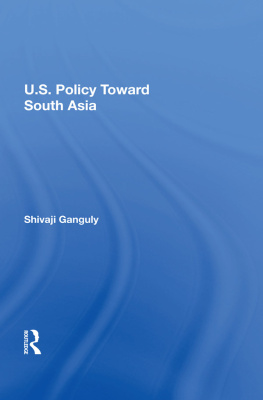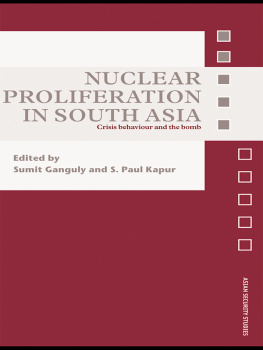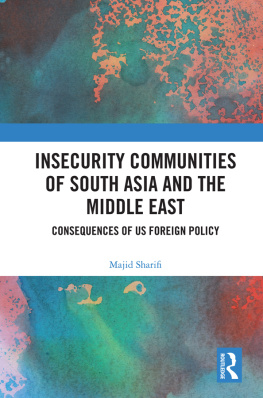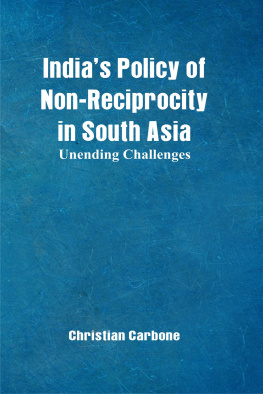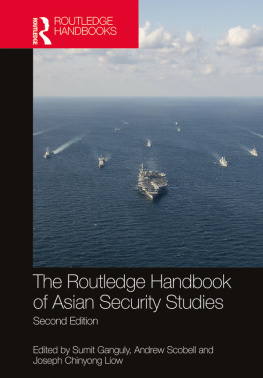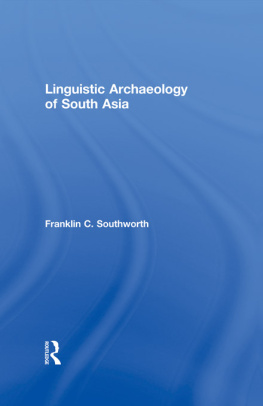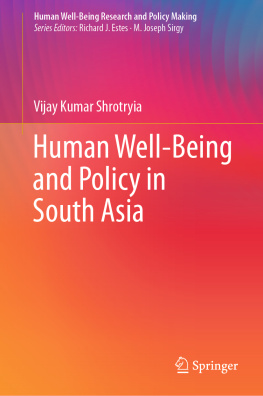U.S. Policy Toward South Asia
First published 1990 by Westview Press
Published 2018 by Routledge
52 Vanderbilt Avenue, New York, NY 10017
2 Park Square, Milton Park, Abingdon, Oxon OX14 4RN
Routledge is an imprint of the Taylor & Francis Group, an informa business
Copyright 1990 by Taylor & Francis
All rights reserved. No part of this book may be reprinted or reproduced or utilised in any form or by any electronic, mechanical, or other means, now known or hereafter invented, including photocopying and recording, or in any information storage or retrieval system, without permission in writing from the publishers.
Notice:
Product or corporate names may be trademarks or registered trademarks, and are used only for identification and explanation without intent to infringe.
Library of Congress Cataloging-in-Publication Data
Ganguly, Shivaji.
U.S. policy toward South Asia / Shivaji Ganguly.
p. cm.(Westview special studies on South and
Southeast Asia)
1. South AsiaForeign relationsUnited States. 2. United
StatesForeign relationsSouth Asia. 3. United StatesForeign
relations1945 . I. Title. II. Series.
DS341.3.U6G36 1990
327. 73054dc20
90-30277
CIP
ISBN 13: 978-0-367-21245-2 (hbk)
Contents
, Stephen P. Cohen
Guide
The nations of South Asia contain a fifth of the human race. They include one state (India) that is certainly the worlds largest democracy and one other (Pakistan) that has been an intermittent ally of the U.S. since 1953. For over thirty-five years Washingtons policy has shifted uneasily from benign (some would call it malign) neglect of this region to intense involvement in its economic, political, and military affairs. Further, the U.S. has often been tom between India and Pakistan, seeing in the former certain ideological and moral values and in the latter certain strategic and military advantages. The situation seems to be permanent: we are not much closer in 1988 to a resolution of these ambiguities than we were in the early 50s, when the U.S. first became deeply engaged in the region.
This book, by a leading Indian scholar, fills an important gap in our understanding of the reasons for Americas sporadicyet fatefulinvolvement in and policy toward South Asia. Dr. Ganguly has asked not only what American policy has been and why certain policies have been followed, but how those policies came to be chosen and implemented. He conclusively demonstrates that the process of policymaking is significant in its own right when it approaches a distant region that has not been crucial to vital American interests. Dr. Ganguly raises important new questions about the American policymaking process and complementsand in some cases supplantsthe existing literature on the subject In doing so, he has contributed a work that will be of immense value both to scholars interested in how policy is made and to policymakers themselves. Most of the latter are ahistorical, their collective institutional memories stretch back no further than their own recent careers. Dr. Ganguly shows us decisively that the contradictions so evident in recent American policy toward South Asiagrappling with the threat of external powers to the region while trying to balance strategic interests in India and Pakistan and still pursuing policies concerning regional economic and political development, non-proliferation, and human rightsflow not only from the complexity of the task but from the process by which these policies are made.
Stephen P. Cohen
University of Illinois at Urbana
The literature on U.S. foreign policy is dominated by relations with the Soviet Union and Weston Europe. American relations with Africa, Southeast Asia, Latin America, and South Asia are relatively neglected and episodic in nature (e.g., studies of traumatic events such as the Korean and Vietnamese wars). This absence of interest is especially marked in the case of South Asia. Yet American decisions have profoundly affected the lives of most South Asians, the societies of regional states, and their external policies. It has often been noted that this influence relationship is disproportionately one-sided: American decisions affect South Asians far more than South Asian decisions can ever affect Americans.
The purpose of this study is to systematically examine the sources and patterns of American responses toward events in South Asia over a period of time, through an examination of four major regional events: three wars and a non-conflict crisis-situation. In doing this we hope to make a contribution not only to what is substantively known about U.S. policy toward South Asia but to the broader literature on foreign policy formation.
This study is thus not a narrative of events but a comparative analysis of the foreign policy of a major global power. Our four case studies involved three different American administrations and include: (1) the Sino-Indian War of 1962 (Kennedy), (2) the food crisis in India of 196567 (Johnson), (3) the Indo-Pakistan War of 1965 (Johnson), and (4) the Indo-Pakistan War of 1971 (Nixon). Of these four case studies, only the second is non-conflictual in character.
These case studies constitute the heart of this book, although they will be preceded by a discussion of the conceptual problems surrounding foreign policy analysis (process, and try to explicate the role conception of those involved in making the decision. A concluding chapter summarizes recent developments in the Carter and Reagan administrations and integrates our findings.
In examining the U.S. response to these issue areas this study assumes that a true understanding of the foreign policy process requires a dual approach: we focus on both the decisional setting and the features of the relevant issue areas that generated a particular American response.
The task of this study is thus both explanatory and exploratory. It tries to combine an examination of individual decisions and actions (or the analysis of a particular situation and event) with that of certain explanatory concepts derived from the relevant literature on foreign policy decisionmaking. Our analysis also proceeds on two different but interrelated levelsthe U.S. foreign policy process and the structure of the U.S.-South Asian interaction continuum. Generally, we first seek to locate the sources of a specific policy decision and follow with an analysis of its significance with reference to the U.S. South Asian policy process.
Asking the right kinds of questions is basic to ail scholarly inquiry, but questions without an analytical framework seldom suggest themselves. In analyzing U.S. policy and process in response to the four select issue areas, we have used in this study a simplified analytical framework; our concern will be with both the rationale behind each decision and the environment within which each foreign policy action took place. By examining the rationale and organizing our analysis around a particular decision, we have made an attempt to assess the significance of the relevant environment in the U.S. foreign policy process.
Several operational steps were involved in the preparation of each case study in this book. First, we identified the decisionmakers and the decisionmaking sequence (initial conditions, decision, and post-decisional actions). Second, we delineated the pertinent elements of the operational environment. Third, we analyzed the various relevant policy documents, public speeches and policy statements, written evidence, joint communiques, and U.N. documents. Fourth, we made use of certain quantitative data (such as volume of aid, trade, and arms sales). Finally, we tried to identify the effect of political pressure as evidenced by a sudden reversal in an existing pattern of relationships, after the application of a visible unilateral action (stoppage of economic and/or arms aid, or a verbal warning regarding the consequences of unacceptable behavior).

